California has more than sixty different species and subspecies of lizards, 15 of which are found in Los Padres National Forest. The most common lizards in California are alligator lizards and fence lizards (also called bluebellies), but there are also many other types of lizards. Skinks are lizards with very smooth, shiny skin; other lizards have horns on their heads, or extraordinarily long tails, or supersized toes; and some lizards have no legs and more closely resemble snakes. But unlike snakes, lizards have external ear openings and moveable eyelids.
Lizards—like other reptiles—are covered in tough, overlapping scales that provide protection and reduce water loss. This adaptation allows lizards to thrive in some of the driest, hottest places around. They are often territorial, with males fighting off other males and using signaling with bright colors or repetitive push-up motions to attract mates and intimidate rivals.
The ability to lose its tail is probably the lizard’s most well-known defense mechanism. Some—like the alligator lizard—pack a mean bite, while others—like the horned lizard—squirt blood out of their eyes to distract predators.
Read below to learn more about the fascinating variety of lizards in our region.
Woodland alligator lizard (Elgaria multicarinata webbii)
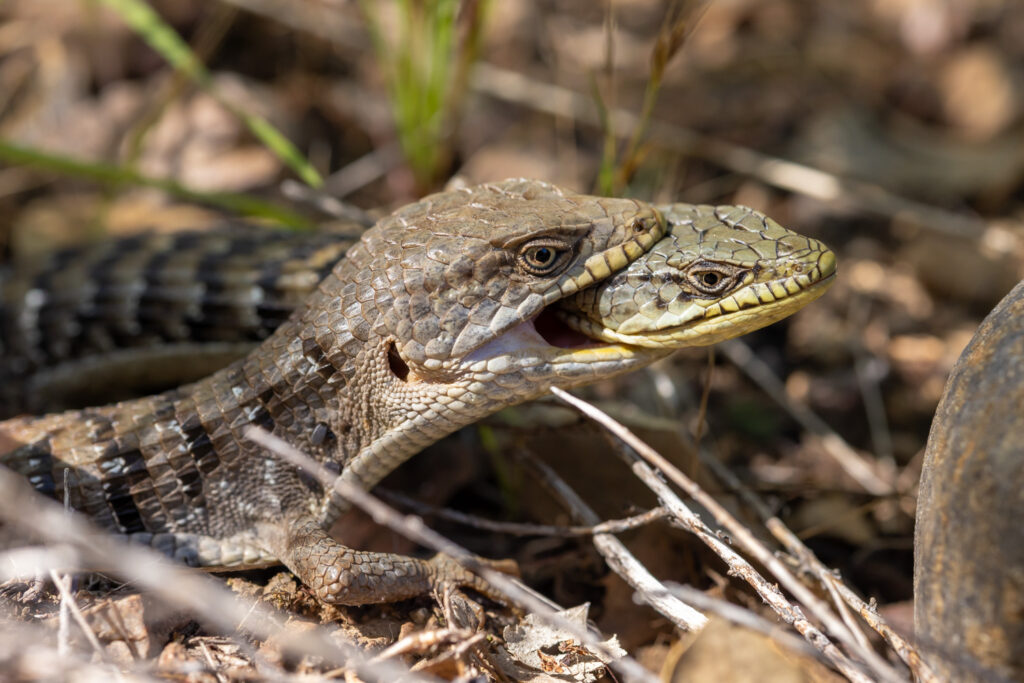
If you’ve found a lizard in your yard or garage, chances are good that it’s an alligator lizard. They’re some of the most common lizards in California, and although seven subspecies of alligator lizards occur in the state, the woodland alligator lizard (also called the San Diego alligator lizard, or more generically, the southern alligator lizard) is the only one found between Monterey and Baja California. It’s also the largest subspecies of alligator lizard, reaching lengths of up to 16 inches from snout to tail.
Bite me! Named for its large head and powerful jaw, the alligator lizard can deliver a painful bite. Mainly a defense mechanism, its bite—in a rather odd display of affection—can also be used to woo a mate. During the breeding season, a male alligator lizard grabs on to the head of a female with his mouth until she is ready to let him mate with her. Her head may remain in his mouth for hours. Aww, so sweet.
Despite their prevalence, alligator lizards are unique in so many ways. They can live up to 15 years, making them one of the longest-lived lizards in the state. They are good swimmers. Unlike most other lizards, they shed their skin in a single intact piece—if you’re lucky enough to find the shed skin of an alligator lizard, it looks like a translucent body with its arms, tail, and head intact. Small ticks are often attached to alligator lizards, especially around the ear openings, and several studies have examined the intricate relationship between alligator lizards and ticks, and how that may spread or inhibit Lyme disease.
Northern legless lizard (Anniella pulchra)
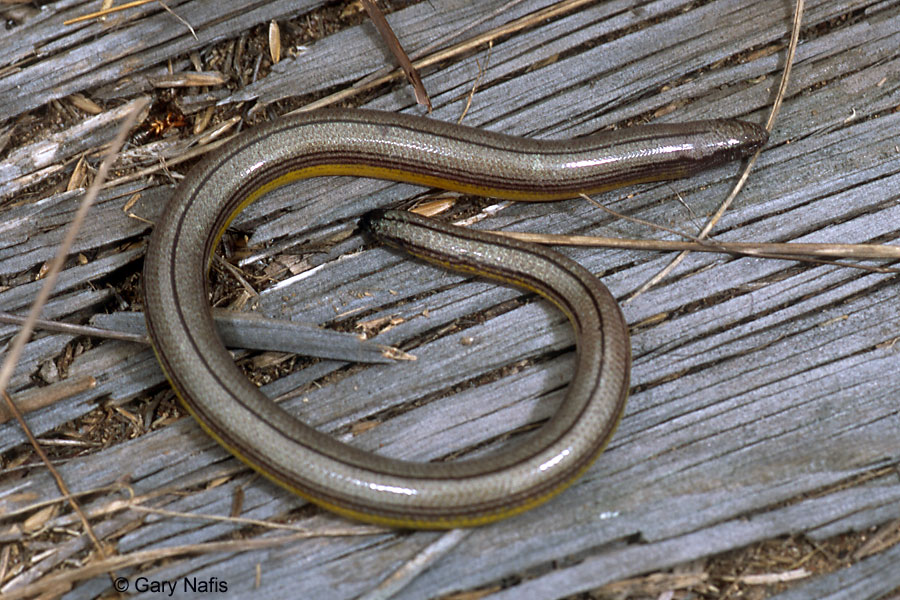
A lizard without legs…umm, so that’s like, a snake, right? Wrong! The legless lizard is sometimes confused for a snake, but it has eyelids (snakes do not). The northern legless lizard ranges from the Bay area to Ventura County and grows up to 7 inches long. It lives mostly underground, burrowing in loose sandy soil for shelter and to ambush insects and other prey.
Most lizards lay eggs, but the legless lizard bears live young—usually two offspring but sometimes up to four. Until recently, it was thought that there was only one species of legless lizard, but in 2013, herpetologists split them into five separate species based on genetics. Legless lizards are only found in California and Baja California. The state of California classifies legless lizards as “species of special concern” and the U.S. Forest Service recognizes legless lizards as “sensitive species.” Much of this lizard’s habitat has been lost due to development, off-road vehicle use, and invasive plants.
Blunt-nosed leopard lizard (Gambelia sila)
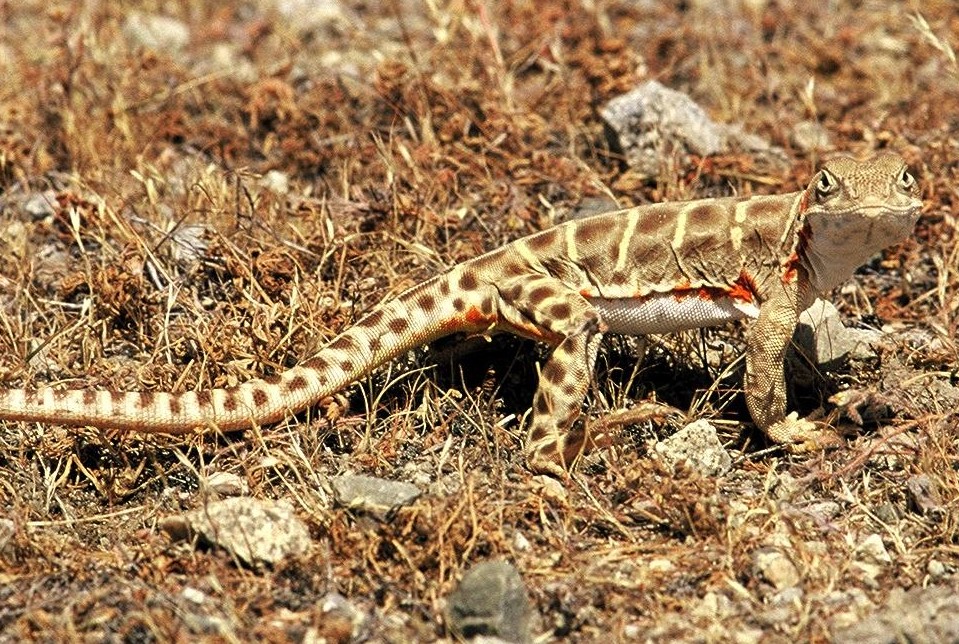
The critically imperiled blunt-nosed leopard lizard was one of the first animals protected under the federal Endangered Species Act (in 1967) and the California Endangered Species Act (in 1971). Blunt-nosed leopard lizards are no longer found throughout most of their former range. Their habitat has been destroyed by urban and agricultural development, overgrazing, oil wells, mining, reservoirs, and off-road vehicles.
Leopard lizards are so named for multi-colored patterns on their backs. These patterns change from stripes to spots as the lizards grow, resembling the spotting of a leopard. Blunt-nosed leopard lizards are often mistaken for the more common long-nosed leopard lizard, which covers a much larger area of the west. Blunt-nosed leopard lizards, on the other hand, are only found in the San Joaquin Valley and surrounding foothills and grasslands. The two types of leopard lizards once hybridized around the Cuyama Valley, but that habitat has been severely degraded and it is unknown whether this hybrid population still exists. The blunt-nosed leopard lizard may still be found around the Ballinger Canyon area, near the eastern corner of Los Padres National Forest, and within the Carrizo Plain National Monument.
Blunt-nosed leopard lizards are relatively large members of the iguana family, with a long tail, powerful hind limbs, and a short, blunt snout. Its tail can grow as long as eight inches, twice the length of its body. They develop bright orange stripes on their sides and underbellies during the breeding season.
Desert banded gecko (Coleonyx variegatus variegatus)
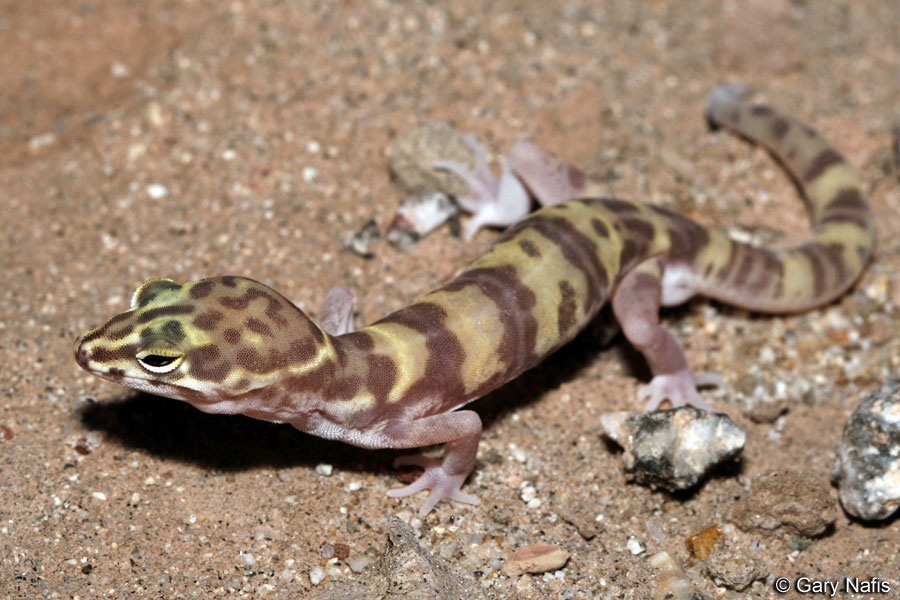
Out of the six subspecies of banded geckos in North America, only two are found in California, and only one is found (barely) in Los Padres National Forest. The desert banded gecko ranges from Ventura County inland to the Antelope Valley and Mojave Desert into Baja California. It was recently documented in the Sespe Wilderness.
Desert banded geckos are small, slender lizards with vertical pupils. Most lizards have round pupils. But since the banded gecko is mostly active at night, its pupils are oriented vertically to help it better gauge distance. This helps them improve their ambush technique by helping them estimate how far away their prey is.
Unlike other geckos, banded geckos do not star in witty insurance commercials. Ever. But they do emit a little squeak when grasped, and we could listen to that cuteness all day (the commercials…meh, not so much). And don’t get us started on those adorable little toes. The round toes of a gecko consist of millions of hairy structures called setae that allow it to “suction-cup” while climbing steep surfaces.
Blainville’s horned lizard (Phrynosoma blainvillii)
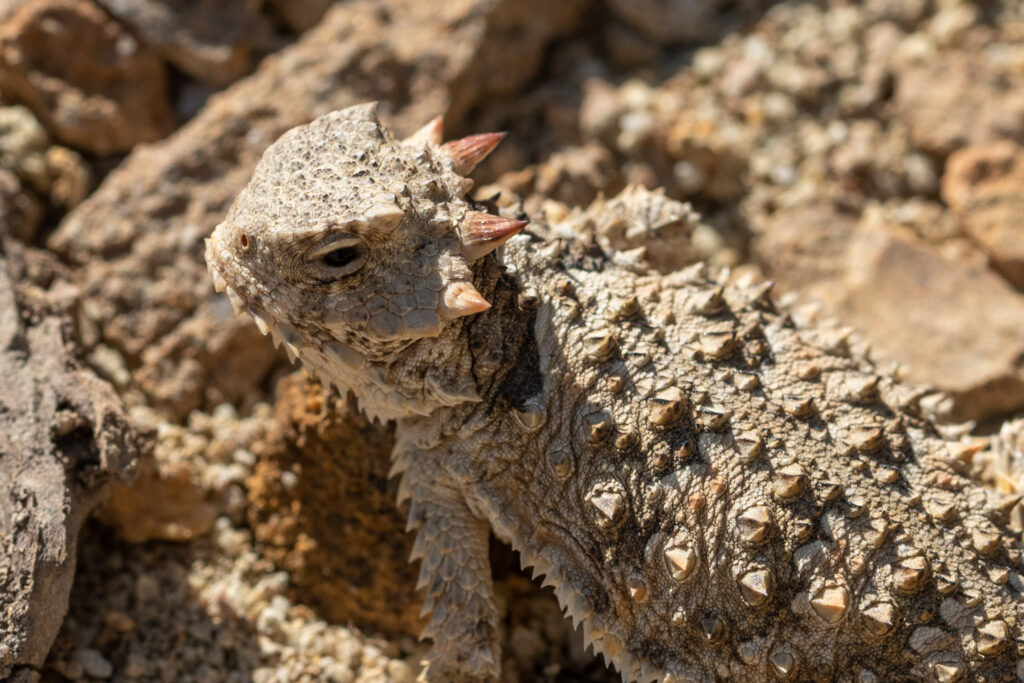
Commonly called a horny toad because of its round body that’s covered with spines, the coast horned lizard. Is. Not. A. Toad. It’s a lizard. With horns and spines and a “don’t mess with me” appearance that works to their advantage. They are found throughout much of California, but have been threatened and eliminated from many areas due to habitat destruction and the spread of non-native Argentinian ants which displace their native ant food source. The state of California considers coast horned lizards to be a “species of special concern” and the Bureau of Land Management classifies the species as “sensitive.” The U.S. Forest Service does not afford any special protections to coast horned lizards.
Its main defense is remaining motionless to avoid detection, even changing its color slightly and partially burying itself to blend in with its surroundings. And if the mere presence of horns is not enough to intimidate you, horned lizards inflate their bodies with air when threatened, open their mouths to make hissing noises, and as a last resort, spray their attackers with blood from the corners of their eyes. Be afraid…be very afraid.
Despite their intimidating appearance, male horned lizards do not defend their territory aggressively like other kinds of lizards. They don’t combat other males during the breeding season, so their bodies tend to be smaller than females.
But wait, who’s Blainville anyway?! The coast horned lizard is officially called Blainville’s horned lizard, in honor of Henri Marie Ducrotay de Blainville, a French zoologist who identified several new species of reptiles, including horned lizards in 1835.
Coast Range Fence Lizard (Sceloporus occidentalis)
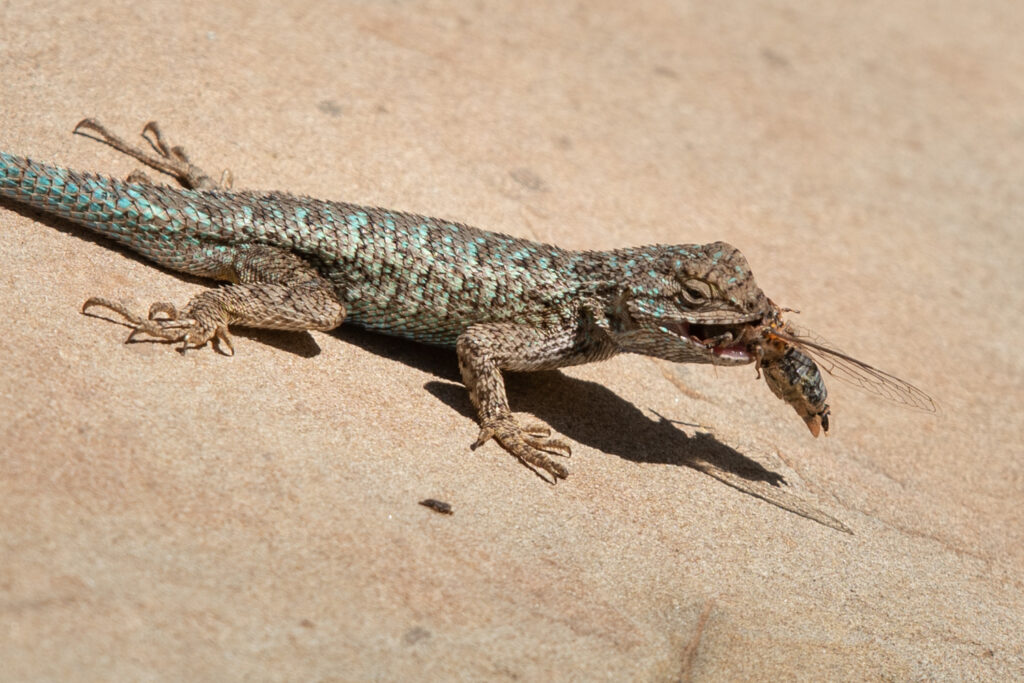
If you see a lizard in California, chances are that it’s a fence lizard. Fence lizards are one of the most common lizards in the state due to their abundance in populated areas and their tendency to be out in the open. California has five types of fence lizards. The one you’ll find in our area is the Coast Range fence lizard (Sceloporus occidentalis boccourtii), which ranges from the Bay Area south to Santa Barbara and Ventura counties. A second type—the Great Basin fence lizard (Sceloporous occidentalis longipes)—is found in the eastern part of Ventura County and other parts of the state.
To distinguish the fence lizard from other common species like the sagebrush and alligator lizards, look at their legs. If you see yellow or orange coloring on the back of the limbs, what you have before you is a fence lizard.
Males have blue markings on the sides of the belly, and a blue patch on the throat, giving this lizard the nickname “bluebelly.” They establish and defend their territory by bobbing their heads and doing repetitive push-ups to show off its blue throat and side colors.
Western sagebrush lizard (Sceloporus graciosus gracilis)
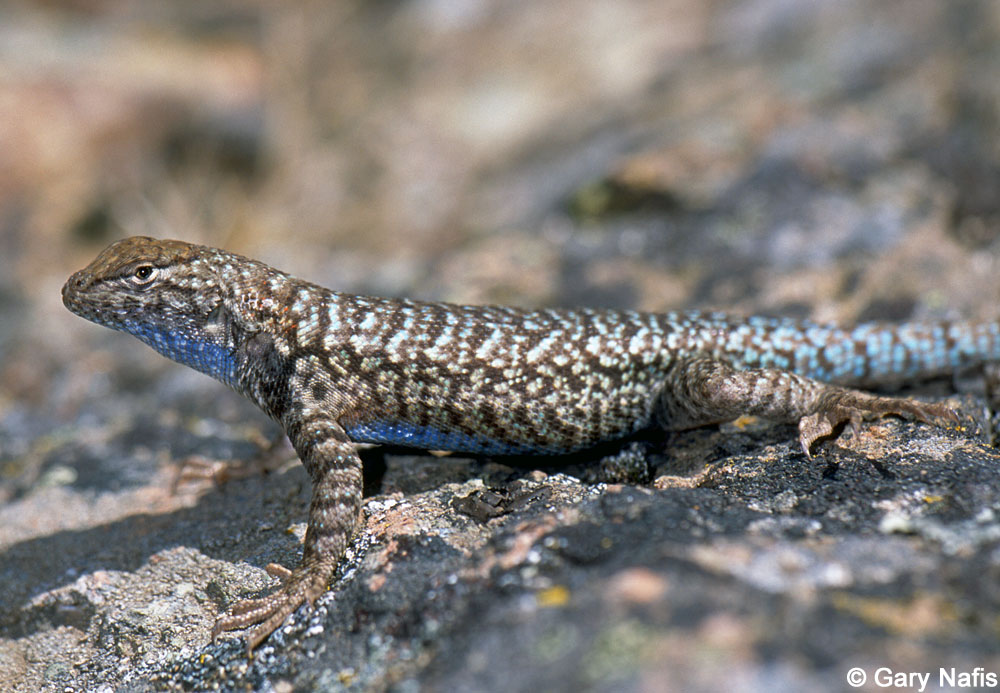
Another common California lizard is the western sagebrush lizard, a smaller lizard that’s distinguished from the western fence lizard by a lack of yellow coloring on the back of its legs. Sagebrush lizards also tend to be found at higher elevations. Male sagebrush lizards have a patch of blue on each side of the belly and on the throat. They defend their territory and attract females with a push-up display that exposes the blue throat and sides.
Of the three subspecies of sagebrush lizards in California, the western sagebrush lizard is found in the interior mountins of Santa Barbara and Ventura counties, as well as Big Sur, the Sierra, and northern California.
Yellow-backed spiny lizard (Sceloporus uniformis)

This fella has yellowish, pointy scales on its back…who’da thunk? You likely won’t see one for more than a split second because they are very wary, quickly retreating under rocks, logs, cracks, and burrows when an intruder nears. Males stand tall, extend their throat to expose the blue coloring, and push their bodies up and down to show their dominance.
Found in the far eastern portion of Los Padres National Forest, near Hungry Valley and Piru Creek, as well as throughout the Mojave and Great Basin desert regions of California and Nevada.
Western side-blotched lizard (Uta stansburiana elegans)

Side-blotched lizards are the most abundant and commonly seen lizard in deserts and dry areas of California. They say the early bird gets the worm, but this “early lizard” is usually the first of the lizards to emerge in the morning, their small size allowing them to warm up quickly. And so what does the early lizard get? The early lizard gets the bug. Nom nom nom. While it may get first dibs on breakfast, side-blotched lizards are short-lived with lifespans of just one year. Life is short!
While its name originates from dark blue-black marks on the sides of the chest behind the front limbs, perhaps the most fascinating aspect of this lizard is how males behave differently based on the color of their throats. Each color has an advantage over one other color. Orange-throated males are dominant, aggressive, and territorial and mate with many females. Yellow-throated males to not defend territories, instead mimicking females to sneak past territorial orange-throated males to find mates. And blue-throated males seek the middle ground; they chase off the yellow-throated males but run off when confronted by the orange-throated males. The blue throats cooperate with other blue males to protect their mates from the orange and yellow-throated males. So fascinating!
Side-blotched lizards are small and brownish-gray. Sometimes they have blue spots on their backs. The western side-blotched lizard is one of five subspecies of side-blotched lizards in North America, and is found throughout California from the Bay Area south.
Western red-tailed skink (Plestiodon gilberti rubricaudatus)

Skinks are secretive lizards with very smooth skin, and four different types of skinks are found in California. The western red-tailed skink (also called Giblert’s skink) is the most widespread variety, found in the interior mountains from San Luis Obispo south to Baja California, as well as in the Tehachapi Mountains and southern Sierra Nevada.
Skinks are known for the bright coloration in their tails, which can be double its body length. It’s a defense mechanism. Predators are attracted to the tail (mmmm…shiny…pretty) and, like many other lizards, skinks can detach their tails to distract their attacker. Red-tailed skinks have bright red or pink tails. The color dulls as the lizard matures.
Skinks are rarely found moving on the ground, preferring to hang out under rocks and logs. They are good burrowers and live up to six years or more. Its tongue is forked and is frequently protruded.
Skilton’s skink (Plestiodon skiltonianus skiltonianus)
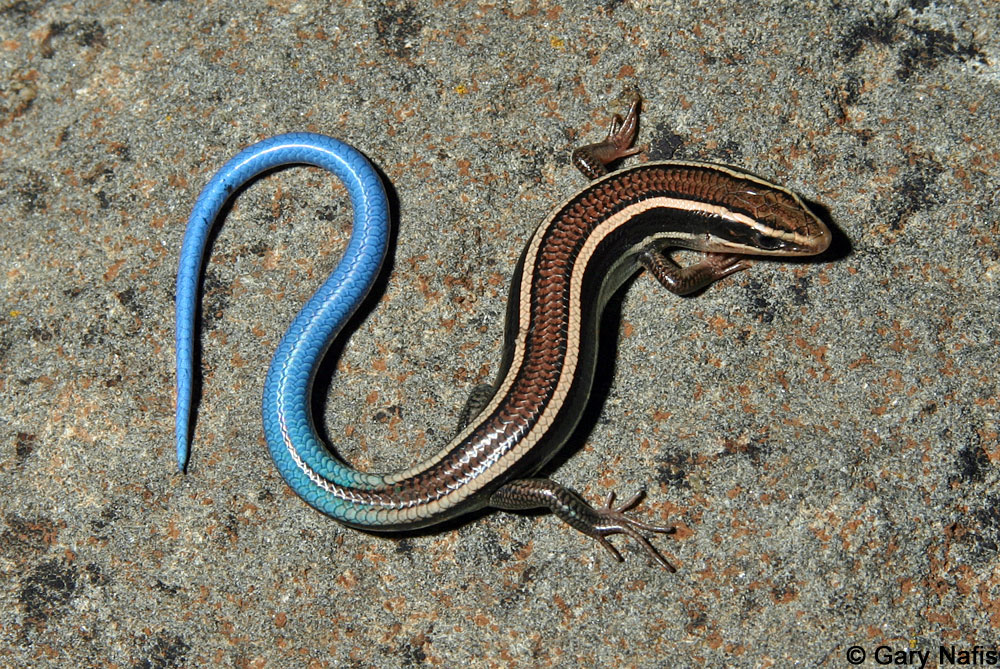
Unlike the bright red/pink tail of the western red-tailed skink, Skilton’s skinks have a bright blue tail when they are young, eventually becoming duller blue on older adults. Like most skinks, they are secretive and typically not seen.
Skilton’s skinks are found throughout the northern part of California, and in the northern Sierra Nevada and foothills, and the coastal mountain ranges south to San Diego County.
Tiger whiptail (Aspidoscelis tigris)
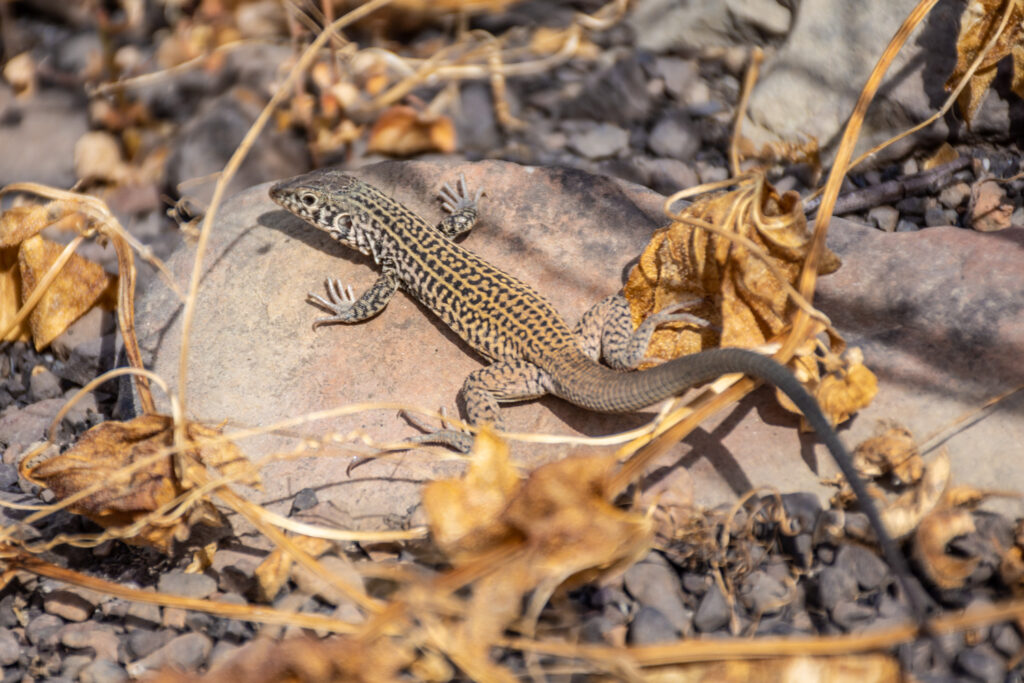
Nearly four dozen species of whiptail lizards are found in North America, including three subspecies of tiger whiptails in California, two of which are found in our area. The California whiptail (Aspidoscelis tigris munda) ranges from northern California to Santa Barbara County, and the San Diegan tiger whiptail (Aspidoscelis tigris stejnegeri) ranges from Ventura County south.
Many whiptail species are all females—parthenogenic is the fancy term for that, meaning that embryos develop somewhat spontaneously from unfertilized egg cells. It’s like reproductive magic. But alas, the tiger whiptail is no sexual magician, as there are both males and females, and they just do their thing, together.
The tiger whiptail is so named because juveniles have well-developed stripes. As tiger whiptails mature, the stripes turn into spots that align into stripes. But what truly sets tiger whiptails apart from other lizards is the shape of the scales on their belly. Most other lizards have, well, scale-shaped scales, but the tiger whiptails scales are most decidedly not that. They also have a forked, snake-like tongue that they often flick around while moving about.
Yucca night lizard (Xantusia vigilis)
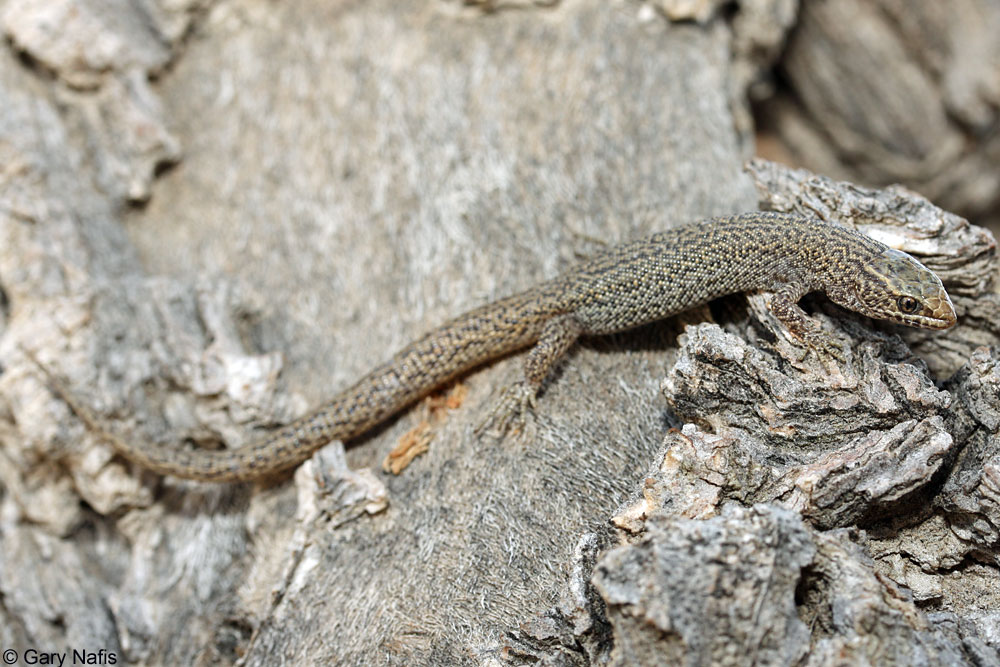
Contrary to their common name, night lizards are active during the day. Okaaay, full disclosure, they can be nocturnal during the heat of summer, so there’s that. But most of the time you’ll find these lizards out and about during daylight hours, and while they’re abundant, they are rather secretive, spending most of their lives under fallen vegetation and debris and under rocks.
Six species of night lizards are found in California, restricted to the southern half of the state. They are absent from most of Los Padres National Forest, but you might find one of these species—yucca night lizard—in the foothills of the San Emigdio Mountains and the Cuyama Valley. The are much more prevalent eastward into the Mojave Desert. As its name suggests, one of their preferred habitats are dead yucca clumps.
Researchers recently discovered that yucca night lizards live in family groups, showing social behavior more like mammals and birds. You see, lizards tend to be a solitary bunch. But yucca night lizards—along with a few other lizard species—have evolved a social system around a nuclear family. The young night lizards hunker down in the same plant debris as its parents and siblings for several years. The young feed themselves and do not receive any direct care from the parents (other than free rent). It’s unknown what advantage, if any, this provides to the species, but it does make yucca night lizards unique from other lizard species.






